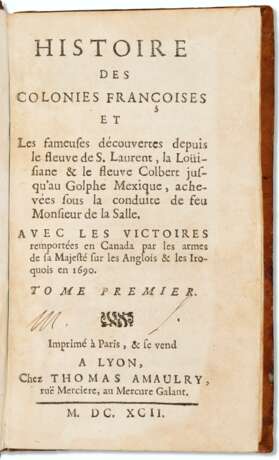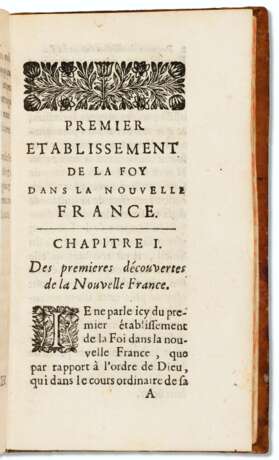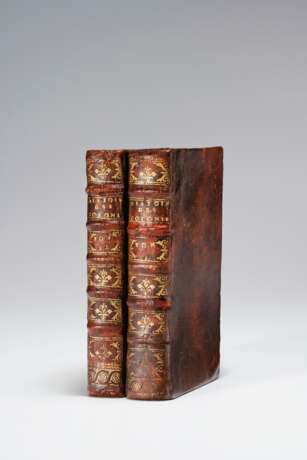ID 411419
Lot 12 | Histoire des Colonies Françoises
Estimate value
$ 100 000 – 150 000
“Supremely important … superlatively rare.”–Howes
First edition, Lyon issue, of this controversial history of the Great Lakes and Niagara region. It includes the first printed account of La Salle’s voyage down the Mississippi, from which Father Hennepin’s more widely published account was plagiarized. And this copy with the suppressed dedication to Count Frontenac. Le Clercq was himself a Recollect Franciscan, but he had a warm relationship with Frontenac—who famously despised the order—and here makes withering commentary about the Jesuits. Le Clercq returned from Canada in late 1686 and published this book under the title Premier établissement de lay foy dans la Nouvelle France in 1691. The work’s extreme rarity has led bibliographers to surmise that it was suppressed, due to perceived sympathies to English claims in the region, or Jesuit retaliation against Frontenac (who is even thought to have authored portions of it), or both. In any case, the printed sheets were taken to Lyon and reissued in 1692 with a new title and—in all other copies located—without the dedication to Frontenac. Howes lists three issues, all with identical collation of the main text, but with varying front and back matter. The present copy has both the 20-page catalogue for the Parisian bookseller, Amable Auroy, which is associated with the second issue; and the 13-page dedication to Count Frontenac, which is associated with only the first and second issues and not the Lyon third issue. The Lyon title pages here are both cancels.
Le Clercq’s work contains many satirical comments about the Jesuits, and Harisse speculates that they were also responsible for the book’s suppression. “It is particularly valuable as containing the first original account of the discoveries of La Salle by two missionaries who accompanied him. From this book also Hennepin drew the account of his pretended discovery of the Mississippi River” (Sabin). "The first of the two eyewitness accounts is by Father Zenobe Member and is of the 1678 La Salle expedition to discover the mouth of the Mississippi; the second is by Father Anastase Douay, one of the four survivors of La Salle's 1685 voyage to Texas. Douay's is the only eyewitness account (Joutel was absent) of La Salle's death at the hands of his own men somewhere between the Sabine and Trinity rivers in Texas" (Nebenzahl).
Le Clercq, whose religious order first traveled to New France with Samuel Champlain, worked as a missionary in Mi'kmaq territory, rich in fish and furs, which had become a major target for resource extraction by the Europeans. Becoming especially close to the Indigenous people of the Gaspé peninsula, Le Clercq learned their language as well as the Mi'kmaq hieroglyphic writing, komqwejwi'kasikl, which he adapted to writing prayers. The present volume is a historical approach to the region which documents the arrival of Recollects in New France, the development of their missions, and the activities of La Salle and Frontenac. Le Clercq’s use of a variety of sources written by others—mainly, the Jesuit Relations—has led some scholars to deny his authorship. Le Clercq's books “remain valuable sources of information about the history of Canada. Father Le Clercq’s writings emerge as a work of great value from the literary, social, religious, and historical point of view. The language is lively, harmonious, and correct, in keeping with the canons of the 17th century, and the ideas are clear and well organized…For the history of the Recollects and of Catholicism in North America, the Premier établissement continues to be a reliable and sincere guide. Consequently Father Chréstien Le Clercq ranks among the great historiographers of New France, and as such he merits our profound admiration” (Dictionary of Canadian Biography). A few copies of early editions have been located with a 1691 map by Rouillard, but it is not thought to have been issued with the text. Howes L-172 (“dd” = “superlatively rare, almost unobtainable”); Sabin 39650-1; Church 718 (Paris).
Two volumes, 12mo (158 x 93mm). Intermittent toning including to title-pages, a little light dampstain at end of vol. 2 and one page with small marginal repair, several words inked over on p. 463, vol. 1; long closed tear to G1, vol. 2. Contemporary calf (rebacked, small repairs at corners). Provenance: Marquis de Montolieu, chevalier de Saint-Louis (1648-1713; ownership inscriptions to both upper pastedowns).
| Address of auction |
CHRISTIE'S 8 King Street, St. James's SW1Y 6QT London United Kingdom | |
|---|---|---|
| Preview |
| |
| Phone | +44 (0)20 7839 9060 | |
| Buyer Premium | see on Website | |
| Conditions of purchase | Conditions of purchase |






